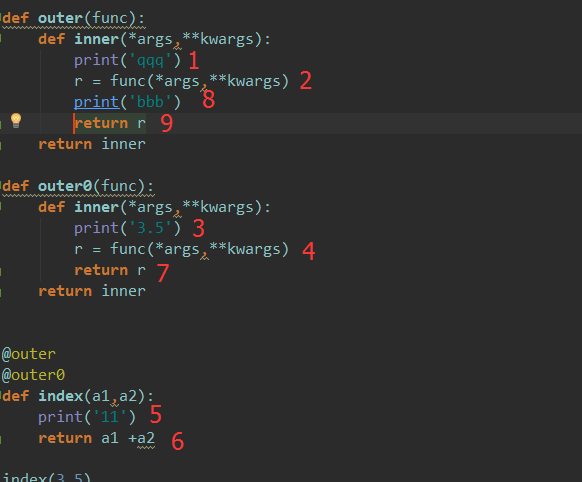文件处理
python对文件进行读写操作的方法与具体步骤,包括打开文件、读取内容、写入文件、文件中的内容定位、及关闭文件释放资源等
open()、file(),这个两函数提供了初始化输入输出(IO)操作的通用接口。两函数的功能相同 在3X版本 file()被抛弃。
1、基本用法:
file_object=open(file, mode='r', buffering=None, encoding=None, errors=None, newline=None, closefd=True)
file_object 是定义一个打开文件的对象,file 可以是个文件,也可以是一个路径,mode是打开的模式,默认的为'r',文件模式有一下几种:
- r,只读模式(默认)。
- w,只写模式。【不可读;不存在则创建;存在则删除内容;】
- a,追加模式。【可读; 不存在则创建;存在则只追加内容;】
其中还有'+'表示同时读写文件
- r+,可读写文件。【可读;可写;可追加】
- w+,写读
- a+,追加
"b"表示处理二进制文件(如:FTP发送上传ISO镜像文件,linux可忽略,windows处理二进制文件时需标注)
- rb
- wb
- ab

class file(object) def close(self): # real signature unknown; restored from __doc__ 关闭文件 """ close() -> None or (perhaps) an integer. Close the file. Sets data attribute .closed to True. A closed file cannot be used for further I/O operations. close() may be called more than once without error. Some kinds of file objects (for example, opened by popen()) may return an exit status upon closing. """ def fileno(self): # real signature unknown; restored from __doc__ 文件描述符 """ fileno() -> integer "file descriptor". This is needed for lower-level file interfaces, such os.read(). """ return 0 def flush(self): # real signature unknown; restored from __doc__ 刷新文件内部缓冲区 """ flush() -> None. Flush the internal I/O buffer. """ pass def isatty(self): # real signature unknown; restored from __doc__ 判断文件是否是同意tty设备 """ isatty() -> true or false. True if the file is connected to a tty device. """ return False def next(self): # real signature unknown; restored from __doc__ 获取下一行数据,不存在,则报错 """ x.next() -> the next value, or raise StopIteration """ pass def read(self, size=None): # real signature unknown; restored from __doc__ 读取指定字节数据 """ read([size]) -> read at most size bytes, returned as a string. If the size argument is negative or omitted, read until EOF is reached. Notice that when in non-blocking mode, less data than what was requested may be returned, even if no size parameter was given. """ pass def readinto(self): # real signature unknown; restored from __doc__ 读取到缓冲区,不要用,将被遗弃 """ readinto() -> Undocumented. Don't use this; it may go away. """ pass def readline(self, size=None): # real signature unknown; restored from __doc__ 仅读取一行数据 """ readline([size]) -> next line from the file, as a string. Retain newline. A non-negative size argument limits the maximum number of bytes to return (an incomplete line may be returned then). Return an empty string at EOF. """ pass def readlines(self, size=None): # real signature unknown; restored from __doc__ 读取所有数据,并根据换行保存值列表 """ readlines([size]) -> list of strings, each a line from the file. Call readline() repeatedly and return a list of the lines so read. The optional size argument, if given, is an approximate bound on the total number of bytes in the lines returned. """ return [] def seek(self, offset, whence=None): # real signature unknown; restored from __doc__ 指定文件中指针位置 """ seek(offset[, whence]) -> None. Move to new file position. Argument offset is a byte count. Optional argument whence defaults to (offset from start of file, offset should be >= 0); other values are 1 (move relative to current position, positive or negative), and 2 (move relative to end of file, usually negative, although many platforms allow seeking beyond the end of a file). If the file is opened in text mode, only offsets returned by tell() are legal. Use of other offsets causes undefined behavior. Note that not all file objects are seekable. """ pass def tell(self): # real signature unknown; restored from __doc__ 获取当前指针位置 """ tell() -> current file position, an integer (may be a long integer). """ pass def truncate(self, size=None): # real signature unknown; restored from __doc__ 截断数据,仅保留指定之前数据 """ truncate([size]) -> None. Truncate the file to at most size bytes. Size defaults to the current file position, as returned by tell(). """ pass def write(self, p_str): # real signature unknown; restored from __doc__ 写内容 """ write(str) -> None. Write string str to file. Note that due to buffering, flush() or close() may be needed before the file on disk reflects the data written. """ pass def writelines(self, sequence_of_strings): # real signature unknown; restored from __doc__ 将一个字符串列表写入文件 """ writelines(sequence_of_strings) -> None. Write the strings to the file. Note that newlines are not added. The sequence can be any iterable object producing strings. This is equivalent to calling write() for each string. """ pass def xreadlines(self): # real signature unknown; restored from __doc__ 可用于逐行读取文件,非全部 """ xreadlines() -> returns self. For backward compatibility. File objects now include the performance optimizations previously implemented in the xreadlines module. """ pass

class TextIOWrapper(_TextIOBase): """ Character and line based layer over a BufferedIOBase object, buffer. encoding gives the name of the encoding that the stream will be decoded or encoded with. It defaults to locale.getpreferredencoding(False). errors determines the strictness of encoding and decoding (see help(codecs.Codec) or the documentation for codecs.register) and defaults to "strict". newline controls how line endings are handled. It can be None, '', ' ', ' ', and ' '. It works as follows: * On input, if newline is None, universal newlines mode is enabled. Lines in the input can end in ' ', ' ', or ' ', and these are translated into ' ' before being returned to the caller. If it is '', universal newline mode is enabled, but line endings are returned to the caller untranslated. If it has any of the other legal values, input lines are only terminated by the given string, and the line ending is returned to the caller untranslated. * On output, if newline is None, any ' ' characters written are translated to the system default line separator, os.linesep. If newline is '' or ' ', no translation takes place. If newline is any of the other legal values, any ' ' characters written are translated to the given string. If line_buffering is True, a call to flush is implied when a call to write contains a newline character. """ def close(self, *args, **kwargs): # real signature unknown 关闭文件 pass def fileno(self, *args, **kwargs): # real signature unknown 文件描述符 pass def flush(self, *args, **kwargs): # real signature unknown 刷新文件内部缓冲区 pass def isatty(self, *args, **kwargs): # real signature unknown 判断文件是否是同意tty设备 pass def read(self, *args, **kwargs): # real signature unknown 读取指定字节数据 pass def readable(self, *args, **kwargs): # real signature unknown 是否可读 pass def readline(self, *args, **kwargs): # real signature unknown 仅读取一行数据 pass def seek(self, *args, **kwargs): # real signature unknown 指定文件中指针位置 pass def seekable(self, *args, **kwargs): # real signature unknown 指针是否可操作 pass def tell(self, *args, **kwargs): # real signature unknown 获取指针位置 pass def truncate(self, *args, **kwargs): # real signature unknown 截断数据,仅保留指定之前数据 pass def writable(self, *args, **kwargs): # real signature unknown 是否可写 pass def write(self, *args, **kwargs): # real signature unknown 写内容 pass def __getstate__(self, *args, **kwargs): # real signature unknown pass def __init__(self, *args, **kwargs): # real signature unknown pass @staticmethod # known case of __new__ def __new__(*args, **kwargs): # real signature unknown """ Create and return a new object. See help(type) for accurate signature. """ pass def __next__(self, *args, **kwargs): # real signature unknown """ Implement next(self). """ pass def __repr__(self, *args, **kwargs): # real signature unknown """ Return repr(self). """ pass buffer = property(lambda self: object(), lambda self, v: None, lambda self: None) # default closed = property(lambda self: object(), lambda self, v: None, lambda self: None) # default encoding = property(lambda self: object(), lambda self, v: None, lambda self: None) # default errors = property(lambda self: object(), lambda self, v: None, lambda self: None) # default line_buffering = property(lambda self: object(), lambda self, v: None, lambda self: None) # default name = property(lambda self: object(), lambda self, v: None, lambda self: None) # default newlines = property(lambda self: object(), lambda self, v: None, lambda self: None) # default _CHUNK_SIZE = property(lambda self: object(), lambda self, v: None, lambda self: None) # default _finalizing = property(lambda self: object(), lambda self, v: None, lambda self: None) # default
2、文件操作常用的方法:
f = open('text.txt','r+')
f.read() #读取指定字节数据
f.write('ok') #写入指定内容本次写入'ok'
f.writelines() #将一个字符串列表写入文件
f.flush() #把缓冲区的刷如到硬盘
f.readline #读取一行
f.readlines #读取所有数据,并根据换行保存值列表
f.tell() #获取当前指针
f.seek() #指定文件中指针位置
f.truncate() #截断数据,仅保留指定之前数据
f.close() #关闭文件
3、with
为了避免忘记关闭文件,可以通过管理上下文,即
with open('log','r') as f:
当with代码块执行完毕时,内部会自动关闭并释放文件资源。
在Python2.7后,with支持同时打开多个文件:
with open('text','r') as f1,open('log','w') as f2:
pass
冒泡算法
冒泡排序是一种简单的排序算法它重复地走访过要排序的数列,一次比较两个元素,如果他们的顺序错误就把他们交换过来如下图:

需求:请按照从小到大对列表 [13, 22, 6, 99, 11] 进行排序,
首先进行排序把列表里面最大的元素换到最后,需要接入第三个元素代码如下:
for i in range(len(li) - 1):
if li[i] > li[i +1]:
temp = li[i]
li[i]= li[i+1]
li[i + 1] = temp
print(li)
通过上面的方法就可以把列表中的99换到最后,既然我们实现了对一个元素的排序下面我们将实现对整个列表的排序:
for j in range(1,len(li)):
for i in range(0,len(li) -j ):
if li[i] > li[i +1]:
temp = li[i]
li[i]= li[i+1]
li[i + 1] = temp
print(li)
####output####
[6, 11, 13, 22, 99]
ok,上面的列表完成排序冒泡排序如此简单实现,下面谈一谈装饰器
装饰器
装饰器是一个可调用的对象(a callable),在python 中函数是对象,当然是可调用的,所以装饰器是一个函数,我们称其为函数装饰器。这个可调用对象以一个函数作为参数,并且返回另一个函数(来替换参数那个函数)比如:
def outer(fun):
def inner():
print('hello')
fun()
return inner
outer 是一个装饰器,它是一个函数,它可以接受一个函数fun作为参数 返回另一个函数inner。为什么叫装饰器?,在返回函数inner()的内部,调用了fun(),而且做了额外的操作,相当于'装饰'了函数fun()
如何使用装饰器那?
def fun1():
pass
def fun2():
pass
fun1 = outer(fun1)
fun2 = outer(fun2)
fun1,fun2的名字都没有变,但是通过调用函数outer(),它们已经指向了另一个函数inner(),即'装饰'了自己。
@操作符
Python提供了@符号,实质上就是上面做的,对一个函数名进行重新赋值,是语法上的技巧,所以上面的代码等价于:
@outer
def fun1():
pass
@outer
def fun2():
pass
但是有一个问题,这个装饰器从功能上看,是要应该可以用来装饰任何函数,但是如果我们用它来装饰了一个带参数的函数
@outer
def fun3(x):
pass
只要不调用fun3,这三行代码不会让python解释器报错, 但是当我们使用fun3时,我们肯定会按照他的定义时的样子去使用它,给它传入一个参数.
>>>fun(3) #这时候就会出错
fun3(3) TypeError: inner() takes 0 positional arguments but 1 was given
当然我们已经很容易知道为什么会这样报错,fun3已经不是指向它定义的那个函数了,它指向inner(),而inner是没有参数的当然会报错.那怎么解决那?修改一下inner()的定义,让它可以接收任意个参数就可以.
def outer(func):
def inner(*args,**kwargs):
print('hello')
func(*args,**kwargs)
return inner
现在给inner传任意个参数都不会出错了,也就是outer可以用来装饰任何一个函数了,不服不行。
但是问题来了,如果给一个函数写两个装饰器会怎么样例如:
@outer1
@outer
def fun1():
print('fun1')
大家可能有疑虑,它们的执行顺序是什么样的,会先输出什么内容?

上图为2层装饰器的调用过程
递归
如果函数包含了对其自身的调用,该函数就是递归的!
利用递归编写斐波那契数列第10个数字的值:
0, 1, 1, 2, 3, 5, 8, 13, 21, 34, 55, 89, 144, 233,377,610,987,1597,2584,4181,6765,10946,17711,28657,46368
代码如下:
def fib1(datp,a,b):
if datp ==10:
return a
a3 = a + b
r = fib1(datp + 1,b,a3)
return r
c = fib1(1,0,1)
####output####
34
另外一种方法:

def fib3(arg): if arg ==1: return 0 elif arg ==2: return 1 else: return fib3(int(arg)-1) + fib3(int(arg)-2) c = fib3('10') print(c)
